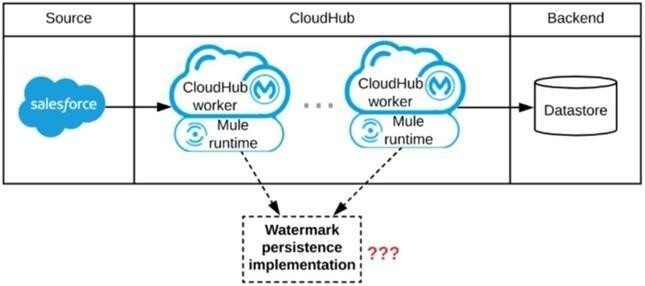At ValidExamDumps, we consistently monitor updates to the MuleSoft MCIA-Level-1 exam questions by MuleSoft. Whenever our team identifies changes in the exam questions,exam objectives, exam focus areas or in exam requirements, We immediately update our exam questions for both PDF and online practice exams. This commitment ensures our customers always have access to the most current and accurate questions. By preparing with these actual questions, our customers can successfully pass the MuleSoft Certified Integration Architect - Level 1 exam on their first attempt without needing additional materials or study guides.
Other certification materials providers often include outdated or removed questions by MuleSoft in their MuleSoft MCIA-Level-1 exam. These outdated questions lead to customers failing their MuleSoft Certified Integration Architect - Level 1 exam. In contrast, we ensure our questions bank includes only precise and up-to-date questions, guaranteeing their presence in your actual exam. Our main priority is your success in the MuleSoft MCIA-Level-1 exam, not profiting from selling obsolete exam questions in PDF or Online Practice Test.
Refer to the exhibit.

A Mule application is being designed to be deployed to several CIoudHub workers. The Mule application's integration logic is to replicate changed Accounts from Satesforce to a backend system every 5 minutes.
A watermark will be used to only retrieve those Satesforce Accounts that have been modified since the last time the integration logic ran.
What is the most appropriate way to implement persistence for the watermark in order to support the required data replication integration logic?

* An object store is a facility for storing objects in or across Mule applications. Mule uses object stores to persist data for eventual retrieval.
* Mule provides two types of object stores:
1) In-memory store -- stores objects in local Mule runtime memory. Objects are lost on shutdown of the Mule runtime.
2) Persistent store -- Mule persists data when an object store is explicitly configured to be persistent.
In a standalone Mule runtime, Mule creates a default persistent store in the file system. If you do not specify an object store, the default persistent object store is used.
MuleSoft Reference: https://docs.mulesoft.com/mule-runtime/3.9/mule-object-stores
An organization uses Mule runtimes which are managed by Anypoint Platform - Private Cloud Edition. What MuleSoft component is responsible for feeding analytics data to non-MuleSoft analytics platforms?
Correct answer is Anypoint Runtime Manager
MuleSoft Anypoint Runtime Manager (ARM) provides connectivity to Mule Runtime engines deployed across your organization to provide centralized management, monitoring and analytics reporting. However, most enterprise customers find it necessary for these on-premises runtimes to integrate with their existing non MuleSoft analytics / monitoring systems such as Splunk and ELK to support a single pane of glass view across the infrastructure.
* You can configure the Runtime Manager agent to export data to external analytics tools.
Using either the Runtime Manager cloud console or Anypoint Platform Private Cloud Edition, you can:
--> Send Mule event notifications, including flow executions and exceptions, to Splunk or ELK.
--> Send API Analytics to Splunk or ELK. Sending data to third-party tools is not supported for applications deployed on CloudHub.
You can use the CloudHub custom log appender to integrate with your logging system. Reference: https://docs.mulesoft.com/runtime-manager/ https://docs.mulesoft.com/release-notes/runtime-manager-agent/runtime-manager-agent-release-notes

Additional Info:
It can be achieved in 3 steps:
1) register an agent to a runtime manager,
2) configure a gateway to enable API analytics to be sent to non MuleSoft analytics platform (Splunk for ex.) -- as highlighted in the following diagram and
3) setup dashboards.

A leading e-commerce giant will use Mulesoft API's on runtime fabric (RTF) to process customer orders. Some customer's sensitive information such as credit card information is also there as a part of a API payload.
What approach minimizes the risk of matching sensitive data to the original and can convert back to the original value whenever and wherever required?
An XA transaction Is being configured that involves a JMS connector listening for Incoming JMS messages. What is the meaning of the timeout attribute of the XA transaction, and what happens after the timeout expires?
* Setting a transaction timeout for the Bitronix transaction manager
Set the transaction timeout either
-- In wrapper.conf
-- In CloudHub in the Properties tab of the Mule application deployment
The default is 60 secs. It is defined as
mule.bitronix.transactiontimeout = 120
* This property defines the timeout for each transaction created for this manager.
If the transaction has not terminated before the timeout expires it will be automatically rolled back.
---------------------------------------------------------------------------------------------------------------------
Additional Info around Transaction Management:
Bitronix is available as the XA transaction manager for Mule applications
To use Bitronix, declare it as a global configuration element in the Mule application
<bti:transaction-manager />
Each Mule runtime can have only one instance of a Bitronix transaction manager, which is shared by all Mule applications
For customer-hosted deployments, define the XA transaction manager in a Mule domain
-- Then share this global element among all Mule applications in the Mule runtime

An organization is designing an integration Mule application to process orders by submitting them to a back-end system for offline processing. Each order will be received by the Mule application through an HTTPS POST and must be acknowledged immediately. Once acknowledged, the order will be submitted to a back-end system. Orders that cannot be successfully submitted due to rejections from the back-end system will need to be processed manually (outside the back-end system).
The Mule application will be deployed to a customer-hosted runtime and is able to use an existing ActiveMQ broker if needed. The ActiveMQ broker is located inside the organization's firewall. The back-end system has a track record of unreliability due to both minor network connectivity issues and longer outages.
What idiomatic (used for their intended purposes) combination of Mule application components and ActiveMQ queues are required to ensure automatic submission of orders to the back-end system while supporting but minimizing manual order processing?